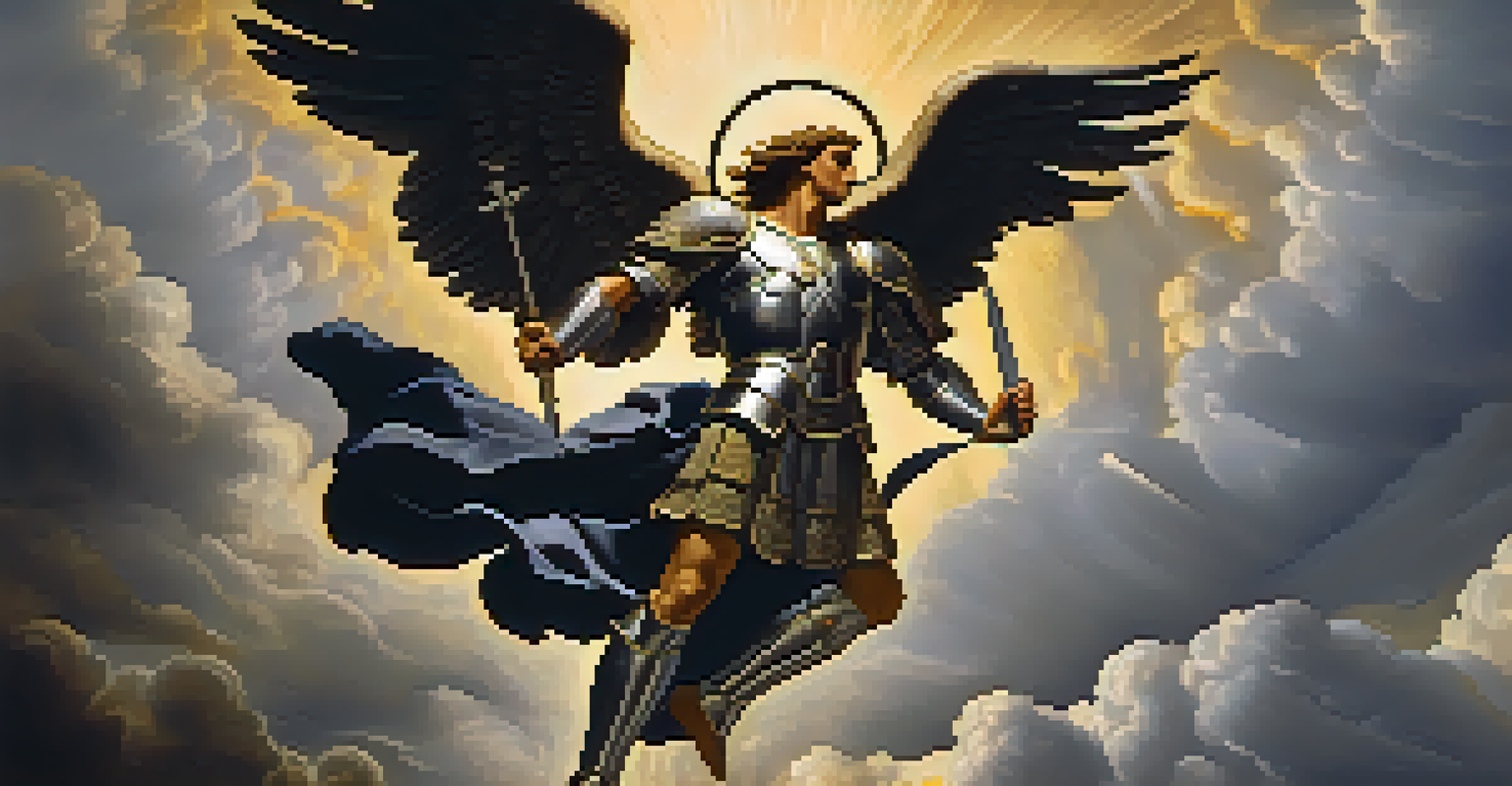Exploring the Use of Allegory in Spiritual Art Forms

Understanding Allegory and Its Role in Spiritual Art
Allegory is a storytelling device that uses symbolic figures and actions to convey deeper meanings. In spiritual art, this technique allows artists to express complex ideas about faith, morality, and the human experience. By representing abstract concepts through tangible images, allegories invite viewers to explore their own beliefs and interpretations.
Art is the most beautiful of all lies; it is the most beautiful of all truths.
For example, a painting depicting a journey through a dark forest may symbolize the struggles of life and the search for enlightenment. Here, the forest represents challenges, while emerging into light signifies spiritual growth. Such representations engage the audience, prompting them to reflect on their own journeys.
This layered approach not only enriches the viewer's experience but also fosters a connection between the art and the observer. By utilizing allegory, spiritual art transcends mere aesthetics, becoming a powerful medium for conveying profound truths and encouraging introspection.
Historical Context of Allegory in Spiritual Art
Throughout history, allegory has played a significant role in various art movements, particularly those with spiritual themes. From the early Christian mosaics to the intricate works of the Renaissance, artists have employed allegorical elements to communicate religious narratives. This tradition highlights the universal desire to explain the inexplicable and depict the divine.

For instance, Botticelli's 'Primavera' not only showcases mythological figures but also embodies themes of rebirth and divine love. This piece illustrates how allegory can weave together various cultural and spiritual motifs, making the artwork resonate across different audiences and eras. Allegorical art doesn't just tell a story; it invites viewers into a dialogue with history and spirituality.
As we delve deeper into these historical contexts, it becomes evident that allegorical elements serve as bridges between the artist's intent and the viewer's interpretation. This connection enriches our understanding of both the artwork and the spiritual themes it represents, solidifying allegory's place in the artistic landscape.
Key Themes in Allegorical Spiritual Art
Allegorical spiritual art often explores themes such as redemption, enlightenment, and the duality of human nature. These concepts serve as the backbone of many artistic representations, inviting viewers to reflect on their personal beliefs and experiences. Artists frequently use allegory to depict the struggle between good and evil, as seen in works portraying the battle between angels and demons.
The artist is the creator of beautiful things. To reveal art and conceal the artist is art's aim.
Take, for example, the depiction of Saint Michael vanquishing Satan. This allegory not only represents the triumph of good over evil but also speaks to the internal battles we all face. By personifying these struggles through allegorical figures, artists create relatable narratives that resonate deeply with viewers.
Moreover, these recurring themes help reinforce the moral lessons conveyed through art. As viewers engage with these allegories, they are prompted to consider their own spiritual journeys and the choices they make, adding layers of meaning to the experience of viewing art.
Notable Artists Who Utilize Allegory in Spiritual Works
Throughout art history, many notable artists have skillfully employed allegory in their spiritual works. Artists like Salvador Dalí and William Blake have created pieces rich with symbolic references that encourage viewers to delve into deeper meanings. Their unique artistic styles and perspectives allow them to convey complex spiritual ideas through vivid imagery and allegorical narratives.
For instance, Blake's 'The Marriage of Heaven and Hell' presents a captivating allegory of the balance between opposing forces. His work challenges traditional notions of good and evil, inviting viewers to reconsider their understanding of spirituality. This innovative approach to allegory not only engages the audience but also stimulates critical thinking about the nature of existence.
By examining the works of these artists, we can appreciate how allegory serves as a tool for spiritual exploration. Their ability to weave intricate stories into their art encourages viewers to embark on their own personal quests for understanding and meaning.
The Impact of Allegory on Modern Spiritual Art
In today's diverse artistic landscape, the use of allegory remains relevant and impactful in spiritual art. Contemporary artists often draw inspiration from traditional allegorical techniques while infusing their unique perspectives and experiences. This blend of old and new allows for innovative expressions of spiritual themes, making them accessible to modern audiences.
For example, many artists now explore issues such as social justice, identity, and environmentalism through spiritual allegories. These themes resonate powerfully in today's world, highlighting the interconnectedness of spirituality and contemporary societal challenges. As a result, allegory serves as a bridge between past and present, allowing for ongoing dialogues about faith and existence.
Moreover, the evolution of technology and media has expanded the ways in which allegorical art can be experienced. Digital platforms enable artists to reach broader audiences, fostering an environment where spiritual allegories can thrive and inspire new generations to engage with these timeless themes.
Interpreting Allegorical Elements in Spiritual Art
Interpreting allegorical elements in spiritual art can be both rewarding and challenging. Each viewer brings their own experiences and perspectives, which influence how they decode the symbols and narratives presented in the artwork. This subjectivity creates a rich tapestry of interpretations, making the viewing experience unique for everyone.
To effectively interpret an allegorical piece, it can be helpful to consider the historical and cultural context in which it was created. Understanding the artist's background, the themes they sought to convey, and the societal issues of their time can provide valuable insights into the artwork. Additionally, taking the time to reflect on personal beliefs and experiences can deepen one’s connection to the piece.
Ultimately, engaging with allegorical spiritual art encourages viewers to embark on a journey of discovery and self-reflection. As individuals explore the layers of meaning within these works, they may uncover new insights into their own spiritual paths and the broader human experience.
The Future of Allegory in Spiritual Art
As we move forward, the future of allegory in spiritual art appears promising and dynamic. Emerging artists are increasingly embracing allegorical techniques to address contemporary issues, creating art that resonates with today's audiences. This evolution allows the tradition of allegory to adapt and thrive in a rapidly changing world.
Moreover, the blending of various art forms—such as performance, installation, and digital media—opens up new avenues for allegorical expression. These innovative approaches can enhance the spiritual narratives conveyed in the artwork, making them more engaging and relevant to modern viewers. As artists push boundaries, we can expect to see fresh interpretations of age-old themes.

In essence, the continued exploration of allegory in spiritual art reflects our ongoing quest for meaning and understanding in an ever-evolving landscape. By embracing this tradition, artists and audiences alike can participate in a dialogue that transcends time, culture, and belief, fostering a deeper connection to the spiritual realm.